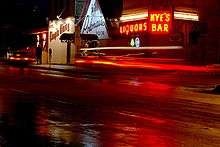Hennepin Avenue
Hennepin Avenue is a major street in Minneapolis, Minnesota, United States. It runs from Lakewood Cemetery (at West 36th Street), north through the Uptown District of Southwest Minneapolis, through the Virginia Triangle, the former "Bottleneck" area west of Loring Park. It then goes through the North Loop in the city center, to Northeast Minneapolis and the city's eastern boundary, where it becomes Larpenteur Avenue as it enters Lauderdale in Ramsey County at Highway 280. Hennepin Avenue is a Minneapolis city street south/west of Washington Avenue, and is designated as Hennepin County Road 52 from Washington Avenue to the county line.
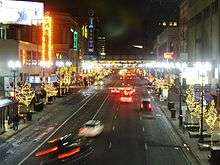
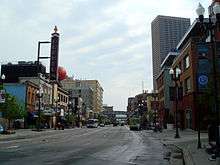
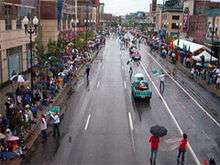
Overview
In Downtown Minneapolis, Hennepin Avenue serves as a major entertainment thoroughfare, dubbed the Hennepin Theatre District. It also serves as the dividing line between "North" and "South" street addresses. Across the river, it divides "Northeast" and "Southeast" street addresses.
The Theatre District contains four historic and architecturally significant theaters for live performances. The State Theatre, the Orpheum Theatre, the Pantages Theatre and the Goodale Theater (formerly the Shubert Theatre on North 7th Street). Also, the Hennepin Center for the Arts and the Cowles Center for Dance and the Performing Arts are located on the artery.
For sections south of the Mississippi River, Hennepin Avenue follows stretches of an old Indian trail from Saint Anthony Falls to Lake Calhoun. It was named after Father Louis Hennepin, a Roman Catholic priest who explored the interior of North America for France while it was under French control. Hennepin Avenue is one of the oldest streets in the city and was the first road to cross the Mississippi River, in 1855, when the first Hennepin Avenue suspension bridge was completed.
Many important institutions and structures have been built on Hennepin, including the Minneapolis Great Northern Depot, the Uptown Theater, the Walker Art Center, the Basilica of St. Mary, St. Mark's Episcopal Cathedral, Hennepin Avenue United Methodist Church, Minneapolis Community and Technical College, Minneapolis Central Library, the Lumber Exchange Building, the Federal Reserve Bank of Minneapolis and the Suburban World Theater. One of the oldest gay bars in the city, The Saloon, is also located on Hennepin.
The street has achieved iconic status in Minneapolis culture, memorialized in songs by Tom Waits, The Hold Steady and Lucinda Williams, among others. Its 600 block downtown was once home to Block E, a sometimes-rowdy collection of bars and independent businesses ultimately acquired by the city and demolished in 1988.[2] It is also a popular parade route, used by the annual Aquatennial celebration held in July, and since the 1990s has been the traditional route of the city's LGBTQ Pride parade.
Once a two-way avenue, the Theatre District portion was changed in 1980 to a one-way northbound with a bus-only lane southbound. "The Environmental Protection Agency was concerned with the air quality in downtown Minneapolis. Turning the streets into one-way lowered the near dangerous high levels of pollution".[3] However, on October 10, 2009, it reverted to a two-way street, with its bike lanes being transferred one block west to First Avenue (which was also switched from one-way to two-way at the same time). This change was hoped by the city to create urban vibrancy, quicker travel times, and to avoid confusing one-ways.
See also
- Nicollet Island
- Mayo Clinic Square, nee Block E
Gallery
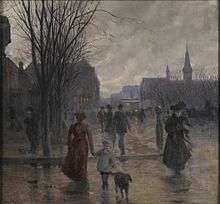 Robert Koehler painting Rainy Evening on Hennepin Avenue c. 1902. The oil on canvas original is at the Minneapolis Institute of Arts
Robert Koehler painting Rainy Evening on Hennepin Avenue c. 1902. The oil on canvas original is at the Minneapolis Institute of Arts
Notes
- Jones, Chris (October 1, 2006). "The Best Bar in America". Esquire. Hearst Communications. Retrieved August 21, 2010.
- "4 Things Everyone Should Know About Block E". 2013-11-26. Retrieved 2019-11-05.
- "Archived copy". Archived from the original on 2009-09-29. Retrieved 2009-10-11.CS1 maint: archived copy as title (link)
External links
| Wikimedia Commons has media related to Hennepin Avenue. |
